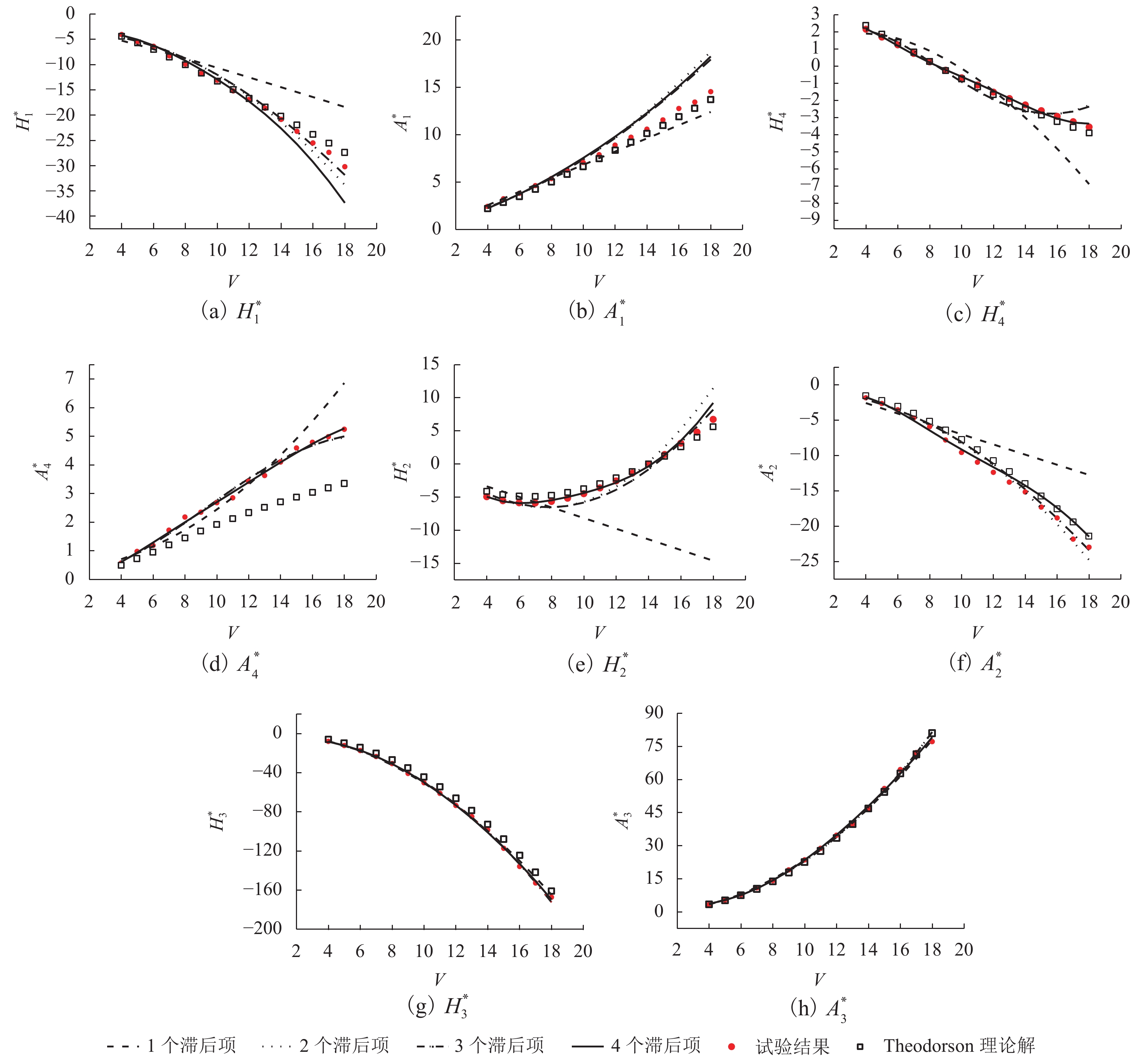Direct Identification of Coefficients of Rational Function Approximation for Self-Excited Aerodynamic Forces
-
摘要: 有理函数系数识别是基于气动力有理函数逼近的桥梁颤振计算的前提条件. 有理函数滞后项的数量对其系数的识别结果影响较大,现有方法中一般仅考虑单滞后项的有理函数系数识别,易造成气动力描述上的失真,进而导致桥梁颤振计算结果不准确. 基于正弦信号的自激气动力在时域上与有理函数对等的原则,采用最小二乘拟合方法,提出了一种可计入多个滞后项的有理函数系数的直接识别算法. 以薄平板模型为对象,利用强迫振动风洞试验获得了自激气动力,采用该算法直接识别了计入不同滞后项的有理函数系数,并分析了滞后项数量对气动力重构精度影响以及对颤振临界风速计算精度的影响.通过自由振动颤振试验获得了实际的颤振风速,进而与采用识别出的有理函数计算的颤振风速进行对比,结果表明:颤振临界风速的试验值与计算值吻合较好,从而验证了本文所提识别算法的准确性;与现有的有理函数系数识别方法相比,本文提出的识别方法兼顾了效率和精度,可广泛用于实际桥梁断面自激气动力有理函数系数的识别中.Abstract: The identification of coefficients of a rational function is the precondition for flutter analysis of long-span bridges based on rational function approximation. The number of lag terms of rational functions has a large influence on the identification accuracy. The coefficient identification of rational function approximation in existing methods are generally based on one lag term, which easily causes distortion problems in both aerodynamic description and coefficients and thus further affects the accuracy of flutter predictions. This paper proposes a direct identification algorithm of rational function coefficients by considering multiple lag terms, according to the principle that the self-excited aerodynamic force of sinusoidal signals is equal to the rational function in time domain and using the least square fitting method.. Then, the forced vibration test of a thin flat plate with harmonic vibration is carried out to characterize the self-excited forces, and the proposed algorithm is used to identify the coefficients of the rational function with different number of lag terms. Influences of the number of lag terms on the accuracy of self-excited aerodynamic force reconstruction and critical flutter wind speed calculation are analyzed. The accuracy of the algorithm is validated by comparing the critical wind speeds obtained from free vibration wind tunnel tests with those from flutter analysis using the identified coefficients. Results show that the calculated values of critical flutter wind speeds are in good agreement with the tested values, which verifies the effectiveness and accuracy of the proposed algorithm. Compared with the existing identification methods of rational function coefficients, the proposed identification method takes both efficiency and accuracy into account, and can be widely used in coefficient identification of rational function approximation for self-excited forces of bridge girders.
-
Key words:
- self-excited forces /
- rational function /
- identification algorithm /
- lag term /
- wind tunnel test
-
表 1 有理函数系数拟合结果(n = 3)
Table 1. Fitting results of rational function coefficients (n = 3)
项 A1,ij A2,ij A3,ij A4,ij A5,ij dl,1 dl,2 dl,3 Ase,11 0.547 −8.025 −0.606 −0.606 8.902 0.140 0.140 1.500 Ase,12 −0.155 1.557 0.250 0.249 0.273 0.140 0.140 1.500 Ase,21 −6.466 −2.520 1.027 1.027 −2.727 0.140 0.140 1.500 Ase,22 3.063 −1.503 −0.479 −0.479 0.154 0.140 0.140 1.500 表 2 计算参数和试验参数
Table 2. Parameters for calculation and tests
工况 m/kg I/(kg•m2•m−1) ωα0/(rad•s) ωh0/(rad•s) ωα0/ωh0 1 5.71 0.158 21.18 15.34 1.38 2 6.44 0.216 23.67 14.70 1.61 3 5.71 0.193 24.53 15.29 1.60 表 3 颤振计算结果对比
Table 3. Comparison of flutter analysis results
方法 工况 Ucr/(m•s−1) 误差/% fcr/Hz 误差/% V 误差/% 风洞试验结果 1 11.8 3.14 9.39 2 16.5 3.38 12.20 3 16.0 3.53 11.33 颤振分析 (1个滞后项) 1 10.9 7.6 3.04 3.2 9.02 3.9 2 14.9 9.7 3.34 1.2 11.15 8.6 3 14.6 8.8 3.46 2.0 10.52 7.1 颤振分析(3个滞后项) 1 11.5 2.7 2.99 4.8 9.60 2.2 2 16.2 1.8 3.20 5.3 12.65 3.7 3 15.8 1.3 3.35 5.1 11.80 4.1 -
SCANLAN R H, TOMKO J J. Airfoil and bridge deck flutter derivatives[J]. Journal of Engineering Mechanics, 1971, 97(6): 1717-1737. LI Q C, LIN Y K. New stochastic theory for bridge stability in turbulent flow[J]. Journal of Engineering Mechanics, 1995, 121(1): 102-116. doi: 10.1061/(ASCE)0733-9399(1995)121:1(102) KARPEL M. Design for active flutter suppression and gust alleviation using state-space aero-elastic modeling[J]. Journal of Aircraft, 1982, 19(3): 221-227. doi: 10.2514/3.57379 KARPEL M. Minimum-state unsteady aerodynamic approximations with flexible constraints[J]. Journal of Aircraft, 1996, 33(6): 1190-1196. SCANLAN R H. Motion-related body force function in two-dimensional low speed flow[J]. Journal of Fluids and Structures, 2000, 14(1): 49-63. doi: 10.1006/jfls.1999.0252 COSTA C, BORRI C. Application of indicial function in bridge deck aeroelasticity[J]. Journal of Wind Engineering and Industrial Aerodynamics, 2006, 94(11): 859-881. doi: 10.1016/j.jweia.2006.06.007 XIE J. CVR method for identification of non-steady aerodynamic model[J]. Journal of Wind Engineering and Industrial Aerodynamics, 1988, 29: 389-397. doi: 10.1016/0167-6105(88)90177-8 谢霁明. 识别非定常气动力模型的初脉冲耦合振动法[J]. 空气动力学学报,1986,4(3): 258-268.XIE Jiming. CVR Method for identification of nonsteady aerodynamic model[J]. ACTA Aerodynamic Sinica, 1986, 4(3): 258-268. 谢霁明,项海帆. 桥梁三维颤振分析的状态空间法[J]. 同济大学学报,1985(3): 1-13.XIE Jiming, XIANG Haifan. A state-space method for 3-D flutter analysis of bridge structures[J]. Journal of Tongji University, 1985(3): 1-13. CHEN X, MATSUMOTO M, AHSAN K. Time domain flutter and buffeting response analysis of bridges[J]. Journal of Engineering Mechanics, 2000, 126(1): 7-16. doi: 10.1061/(ASCE)0733-9399(2000)126:1(7) CHEN X, MATSUMOTO M, KAREEM A. Aerodynamic coupling effects on flutter and buffeting of bridges[J]. Journal of Engineering Mechanics, 2000, 126(1): 17-26. doi: 10.1061/(ASCE)0733-9399(2000)126:1(17) 郭增伟,葛耀君. 桥梁自激力的状态空间模型的时频特性[J]. 振动工程学报,2013,26(2): 199-206. doi: 10.3969/j.issn.1004-4523.2013.02.007GUO Zengwei, GE Yaojun. Time and frequency response characteristics of self-exited force of bridge in state space domain[J]. Journal of Vibration Engineering, 2013, 26(2): 199-206. doi: 10.3969/j.issn.1004-4523.2013.02.007 张志田,胡海波,陈政清. 桥梁自激气动力阶跃函数及时域颤振的数值算法[J]. 土木工程学报,2011,44(2): 99-107.ZHANG Zhitian, HU Haibo, CHEN Zhengqing. Bridge indicial functions for self-excited aerodynamic forces and numerical algorithm for time domain flutter[J]. China Civil Engineering Journal, 2011, 44(2): 99-107. 张志田,陈政清,李春光. 桥梁自激气动力时域表达式的瞬态与极限特性[J]. 工程力学,2011,28(2): 75-85.ZHANG Zhitian, CHEN Zhengqing, LI Chunguang. Limiting and transient characteristics of time domain expressions for bridge self-excited aerodynamic forces[J]. Engineering Mechanics, 2011, 28(2): 75-85. WILDE K, FUJINO Y. Aerodynamic control of bridge deck flutter by active surfaces[J]. Journal of Engineering Mechanics, 1998, 124(7): 718-727. doi: 10.1061/(ASCE)0733-9399(1998)124:7(718) 熊龙,廖海黎,马存明,等. 静风效应对千米级悬索桥颤振的影响[J]. 华中科技大学学报(自然科学版),2016,44(12): 44-49.XIONG Long, LIAO Haili, MA Cunming, et al. Study on aerostatic effects on flutter of kilometer level suspension bridge[J]. J. Huazhong Univ. of Sci. & Tech. (Natural Science Edition), 2016, 44(12): 44-49. 王骑,廖海黎,李明水,等. 桥梁断面非线性自激气动力经验模型[J]. 西南交通大学学报,2013,48(2): 271-277. doi: 10.3969/j.issn.0258-2724.2013.02.013WANG Qi, LIAO Haili, LI Mingshui, et al. Empirical mathematical model for nonlinear motion-induced aerodynamic force of bidge girder[J]. Journal of Southwest Jiaotong University, 2013, 48(2): 271-277. doi: 10.3969/j.issn.0258-2724.2013.02.013 CHOWDHURY A G, SARKAR P P. Experimental identification of rational function coefficients for time-domain flutter analysis[J]. Engineering Structures, 2005, 27(9): 1349-1364. doi: 10.1016/j.engstruct.2005.02.019 CAO B, SARKAR P P. Identification of rational functions using two-degree-of-freedom model by forced vibration method[J]. Engineering Structures, 2012, 43: 21-30. doi: 10.1016/j.engstruct.2012.05.003 SIEDZIAKO B, OISETH O. An enhanced identification procedure to determine the rational functions and aerodynamic derivatives of bridge decks[J]. Journal of Wind Engineering and Industrial Aerodynamic, 2018, 176: 131-142. doi: 10.1016/j.jweia.2018.03.025 李明水. 连续大气湍流中大跨度桥梁的抖振响应[D]. 成都: 西南交通大学, 1993. -






 下载:
下载:



